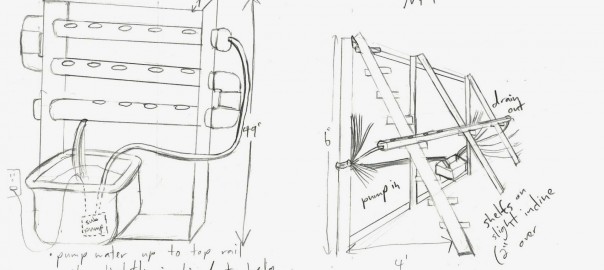The basic idea of the Nutrient Film Technique is that plants sit in net cups suspended a small distance over a thin stream of nutrient solution which is in constant motion.
Generally, a steady stream of water is continually pumped into one end of a channel and a small downward gradient causes the water to flow to the other end thanks to gravity. At the other end of the channel is a connection which allows the water to return to the reservoir, ideally without relying on power so that the water can return to the reservoir in the event of a power outage rather than gathering at one end of the channel. NFT is best used for shallow rooting plants like lettuce and other greens, herbs, strawberries, etc.
The good news:
- By most designs, water drains completely back to the reservoir when power is cut so you don’t need to worry about flooding,
- Plants thrive from the continual flow of water,
- Only a small amount of water is coursing through the system at a time, so you can use a relatively small reservoir of nutrient solution very efficiently.
The bad news:
- Pumps generally must run 24 hours a day,
- Whether the channel(s) are mostly empty or completely full, the reservoir size required doesn’t change, nor does the electricity cost for running pumps,
- The smaller the reservoir (relative to the number/size of the plants), the more often it will need to be topped up and pH checked,
- When pumps are turned off the water drains completely, and because roots have been spoiled by constant water they may start to die relatively quickly.
Example 1
Here’s a hobbyist’s vertical NFT system that’s easy to build and supports a dozen or so plants. Note that it uses PVC pipe, which is popular for DIY NFT applications but is on my personal list of materials to avoid until I get around to doing more research. This system is probably intended for outdoor use or window use since plants are easiest to light with grow lights if they are arranged horizontally.
The water level here comes up above the bottom of the net cups, which is desired initially but would likely be troublesome later. Plants need a water level that reaches the net cup initially, but as they build root systems a lower level is desired so that some of the roots will sit in humid air and receive oxygen. However, if we don’t do anything to control the water level it will only rise later as plants build nice big root systems which take up space in the channel and slow down the passage of water.
A common solution to this dilemma is to design the system so that the water level is well below the bottom of the net cup by default (with no plants in the system) and then devise a sort of removable dam for each channel which can be used when plants are young and removed once roots are established enough to reach the normal water level without help. If you would like to replicate this system, consider using a larger channel, smaller net cup, or weaker pump and adding something to act as a dam when needed.
For another suggested improvement, it would be better to devise a way for the nutrient solution to return to the reservoir a closed, controlled manner rather than dropping in from above so that the reservoir can be covered to block light and prevent algae.
An air pump is often considered optional. If not used, make sure that not all roots are submerged in water and try to have some roots living in a humid air space a la Kratky.
Example 2
By contrast, here’s a setup which was made by an individual but with intentions to grow lettuce for commercial sale.
Commercial channels designed for NFT are used, and nutrient solution is pumped into many channels in parallel rather than the solution flowing from one channel to the next. A DIY A-frame is used with a grow light suspended on an angle.

